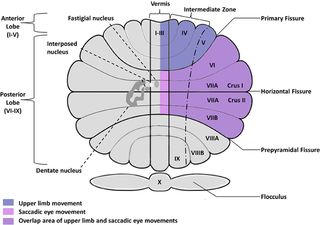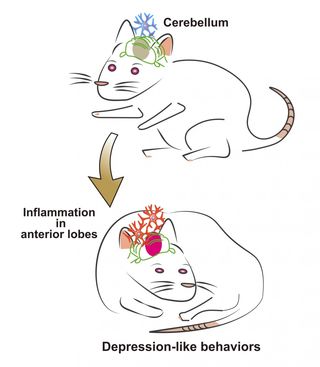Motivation
A Connection Between Motivation and Brain Inflammation
Inflammation of the cerebellum reduces sociability and motivation in lab rats.
Posted September 14, 2019 Reviewed by Lybi Ma

Until the turn of the 21st century, most neuroscientists thought the human cerebellum was only responsible for motor functions, such as the coordination of muscle movements. In recent years, however, a growing body of evidence suggests that the human cerebellum plays a previously unrecognized role in non-motor, higher-order brain functions and influences our thoughts and emotions.

Cerebellar means "relating to the cerebellum." Last year, a review paper (Depping et al., 2018) analyzed neuroimaging data from a handful of human studies that investigated abnormal cerebellum structure in specific non-motor cerebellar regions. This mini-review article from Frontiers in Psychiatry identified a possible link between increased gray matter volume in lobule IX of the cerebellum and major depressive disorder (MDD).
This review (2018) also identified that some human patients with MDD showed less robust functional connectivity of white matter tracts between specific regions (i.e., "microzones") within each cerebellar hemisphere and corresponding cerebral hemispheres, as well as other brain regions.
As Malte Depping and co-authors explain, "At the functional level, connectivity analyses have shown reduced cerebro-cerebellar coupling of lobules VI and VIIA/B with prefrontal, posterior parietal, and limbic regions in patients with MDD."
Acute Cerebellar Inflammation Induces 'Depression-Like' Behavior in Lab Rats

This week, a team of researchers from Kyoto University in Japan published a new study—based on a series of state-of-the-art experiments in rats—which reports that acute inflammation of the cerebellum puts the "little brain" into a hyper-active and "overexcited" state that temporarily reduced motivation and sociability of rodents living together in a laboratory. According to the researchers, these behaviors in lab rats are analogous to "depression-like" behaviors in humans. These findings (2019) were published on September 10 in the journal Cell Reports.
"Even though we now know more about the cerebellum's role in higher-order brain functions, the detailed signal transduction machinery remains a mystery. We know even less about what happens in the brain during excessive immune activity," team leader and senior author Gen Ohtsuki of Kyoto University's Hakubi Center for Advanced Research said in a news release. "So, we conducted a series of experiments where we activated the immune cells in the cerebellum and observed the results."
As a way to fend of bacteria and respond to viruses, the brain's immune cells (known as "microglia") trigger inflammation in an attempt to mitigate damage. Ohtsuki and colleagues found that microglia-triggered inflammation caused neurons in the cerebellum to fire at an increased rate. This caused a chain reaction that put the cerebellum in a hyper-excited state.
Notably, this immune-triggered response in the cerebellum was linked to changes in the animals' behavior. When rats were temporarily subjected to acute cerebellar inflammation triggered by an immune response, their sociability and motivation decreased significantly. The good news: These behavioral changes were only temporary; when cerebellar swelling subsided, motivation rebounded.
"These behavioral modulations are signs of 'depression-like' behavior. Once the inflammation subsided, they were back to normal," Ohtsuki said. "Moreover, the phenotype can be rescued if the rats are treated with neuro-immunity suppressants and inflammatory cytokines. We also investigated if higher-order brain regions were affected; fMRI studies on the rats show a clear increase in activity in the prefrontal cortex, highlighting the interconnectedness of the cerebellum to higher-order brain regions."
Although this study used a murine model, there is a possibility that previously unrecognized microglia-triggered inflammation of the cerebellum may be linked to depressive symptoms in some humans. However, it's too early to draw any cause-and-effect conclusions based on this study. Ohtsuki and his team are encouraged by their initial findings but emphasize that more research is needed.
"Excessive immune activity in the brain can induce behavioral pathology, and we expect it to be involved in other mental and cognitive disorders such as dementia. But to understand anything about the pathological mechanisms we need to combine this with additional data such as genetic risk factors," Ohtsuki concluded in a statement. "In this study, we focused on inflammation. In the future, we will begin firmly clarifying the physiological, molecular, and genetic aspects of these behavioral changes."
References
Masamichi Yamamoto, Minsoo Kim, Hirohiko Imai, Yamato Itakura, Gen Ohtsuki. "Microglia-Triggered Plasticity of Intrinsic Excitability Modulates Psychomotor Behaviors in Acute Cerebellar Inflammation." Cell Reports (First published: September 10, 2019). DOI: 10.1016/j.celrep.2019.07.078
Malte S. Depping, Mike M. Schmitgen, Katharina M. Kubera, and Robert C. Wolf. "Cerebellar Contributions to Major Depression." Frontiers in Psychiatry (First published: November 29, 2018) DOI: 10.3389/fpsyt.2018.00634
Jeremy D. Schmahmann, Jeffrey B. Weilburg Janet C. Sherman. "The Neuropsychiatry of the Cerebellum — Insights from the Clinic." The Cerebellum (First published: September 2007) DOI: 10.1080/14734220701490995
Jeremy D. Schmahmann "Disorders of the Cerebellum: Ataxia, Dysmetria of Thought, and the Cerebellar Cognitive Affective Syndrome." The Journal of Neuropsychiatry and Clinical Neurosciences (2004) DOI: 10.1176/jnp.16.3.367
Jeremy D. Schmahmann and Janet C. Sherman. "The Cerebellar Cognitive Affective Syndrome." Brain: A Journal of Neurology (1998) DOI: 10.1093/brain/121.4.561
Jeremy D. Schmahmann. "Dysmetria of Thought: Clinical Consequences of Cerebellar Dysfunction on Cognition and Affect." Trends in Cognitive Sciences (1998) DOI: 10.1016/S1364-6613(98)01218-2




